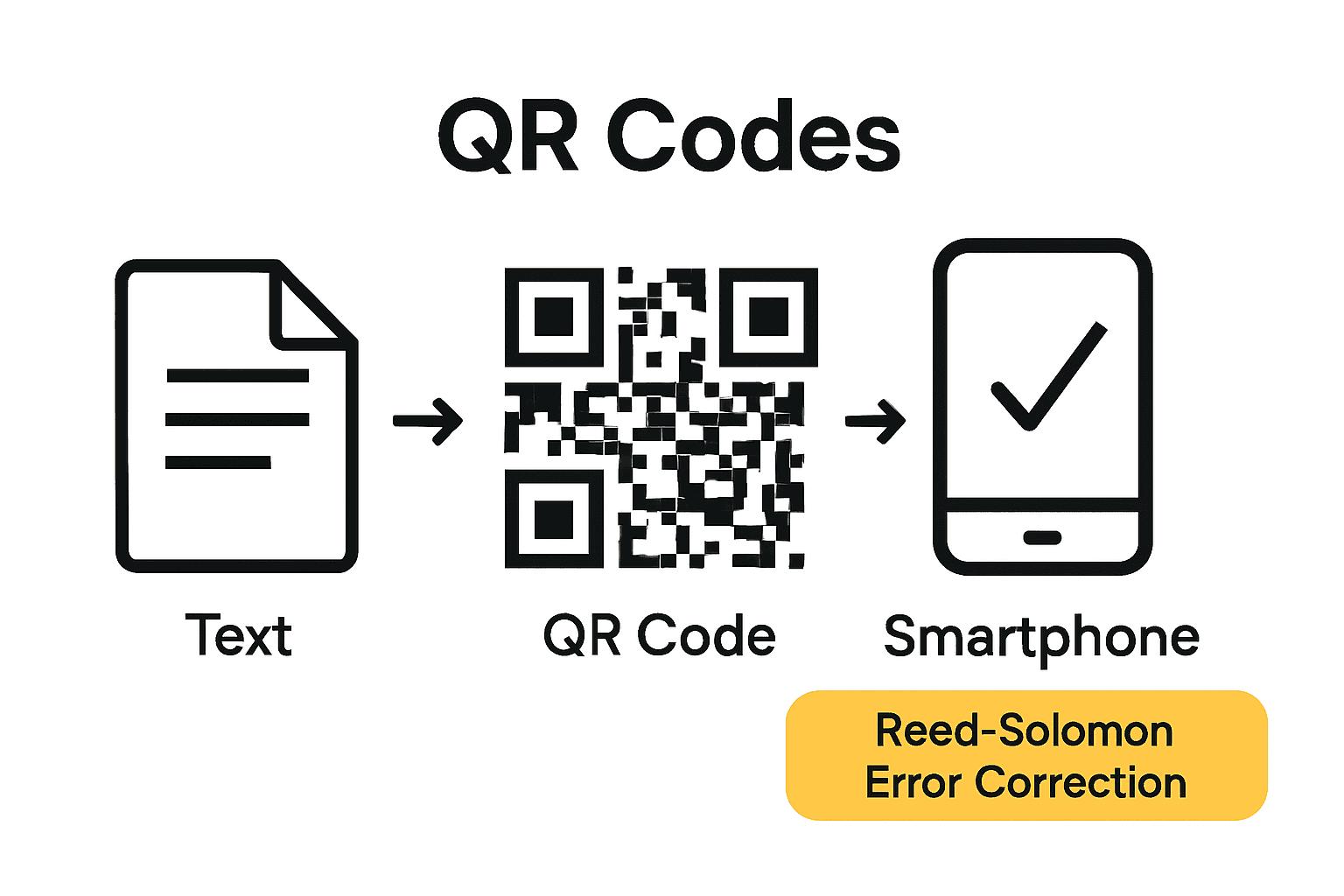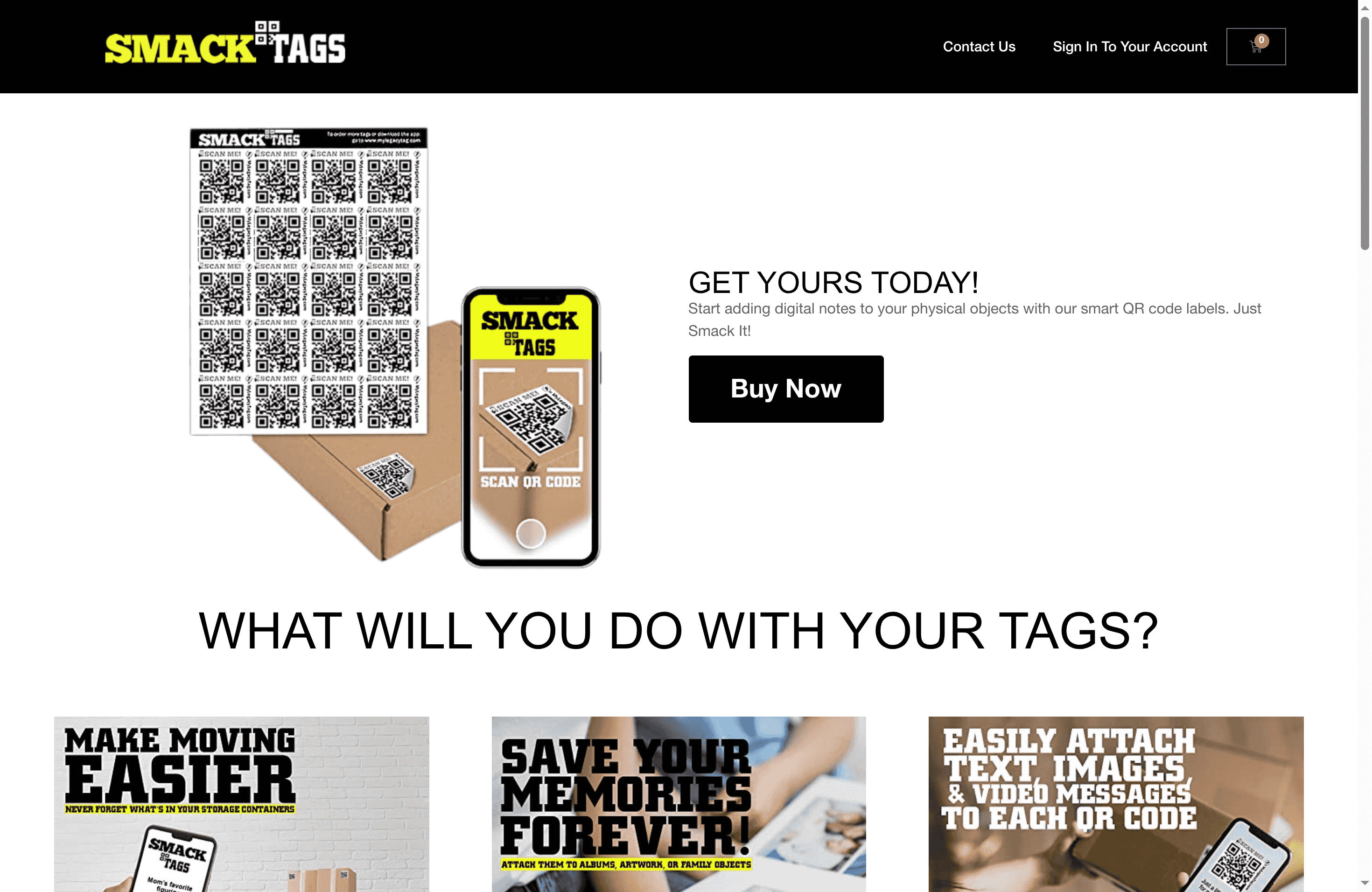How QR Codes Store Information: Complete Guide
QR codes might look simple, but they pack a surprising punch. More than two billion QR codes are scanned every year worldwide, linking shoppers, students, and professionals to rich digital content in seconds. From making contactless payments to storing important details, these tiny patterns bridge the gap between our physical and digital worlds. Understanding how QR codes work unlocks countless new ways to share, store, and secure your information with just a quick scan.
Table of Contents
- What Are QR Codes And How They Work
- Types Of QR Codes And Data Encoding Methods
- How Information Gets Stored And Retrieved
- Common Uses For Personal And Business Storage
- Security, Privacy Risks, And Limitations
Key Takeaways
| Point | Details |
|---|---|
| QR Code Functionality | QR codes are versatile digital barcodes that store and transfer various types of information, enabling quick access through camera-enabled devices. |
| Encoding Modes | QR codes utilize four primary encoding modes (Numeric, Alphanumeric, Byte/Binary, Kanji) to efficiently manage different data types and formats. |
| Privacy and Security Risks | Users should be cautious of scanning QR codes from untrusted sources, as they can lead to harmful websites and data breaches. |
| Applications | QR codes are widely used in personal, business, and educational settings for organizing information and enhancing interactive experiences. |
What Are QR Codes And How They Work
A QR code, short for Quick Response code, is a fascinating two-dimensional matrix barcode that packs a surprising amount of digital information into a small square design. According to Wikipedia, these innovative graphic codes were first developed in 1994 by Denso Wave, a Japanese company looking to streamline product tracking and identification processes.
At its core, a QR code works by encoding data both horizontally and vertically, which allows it to store significantly more information compared to traditional one-dimensional barcodes. As explained by Nova Library Guides, these codes can be scanned using devices with cameras like smartphones, instantly transforming visual patterns into actionable digital information.
QR codes are incredibly versatile and can store various types of data, including:
- Website URLs
- Contact information
- Plain text messages
- Application launch instructions
- Wifi network credentials
- Event details
The magic happens through a series of black and white squares arranged in a specific grid pattern. When a camera-enabled device scans the code, specialized software decodes these squares, translating the geometric pattern into readable digital content. This technology has transformed how we quickly access and share information, making complex data transfer as simple as pointing your phone at a small graphic.
For artists and crafters looking to preserve memories and create interactive experiences, guide on information access via QR codes can provide even more insights into these powerful digital tools.
Types Of QR Codes And Data Encoding Methods
QR codes are not a one-size-fits-all technology. According to Wikipedia, they actually come in several specialized variations designed to meet different data storage and space requirements. These codes utilize four primary encoding modes that determine how information can be processed and stored.
The four primary encoding modes include:
- Numeric Mode: Stores numerical digits with maximum efficiency
- Alphanumeric Mode: Handles numbers and uppercase letters
- Byte/Binary Mode: Supports raw data and computer files
- Kanji Mode: Specifically designed for Japanese character encoding
Beyond these standard modes, QR code technology has developed specialized variants to address unique design challenges. Wikipedia highlights two notable innovations: Micro QR codes and Rectangular Micro QR codes. Micro QR codes are compact versions ideal for smaller spaces, while Rectangular Micro QR codes offer a more flexible rectangular format that can fit into tighter or uniquely shaped areas.
For professionals and creatives seeking to optimize their information storage strategies, understanding these different QR code types can unlock powerful communication possibilities. When designing QR codes for specific projects, consider the encoding mode and variant that best matches your data and space constraints.

To explore more about implementing QR codes effectively in various settings, check out our guide on the role of QR codes in business, which provides deeper insights into practical applications.
How Information Gets Stored And Retrieved
QR codes are ingenious digital storage systems that transform complex information into a simple visual grid. According to Wikipedia, these codes store data by precisely arranging black and white squares in a strategic pattern, where each square’s position carries specific encoded information.
The scanning process is remarkably sophisticated. When a device captures a QR code image, specialized software meticulously interprets the geometric pattern, translating those seemingly random squares into readable digital content. As explained by Nova Library Guides, this allows for instantaneous information retrieval without any manual typing or complex input processes.
QR codes come with a brilliant built-in fail-safe mechanism. Wikipedia reveals that these codes incorporate error correction algorithms, specifically the Reed-Solomon method, which enables data recovery even if portions of the code are damaged, obscured, or partially unreadable. This means your stored information remains accessible under less-than-perfect scanning conditions.

Understanding how QR codes work is crucial for artists, crafters, and professionals looking to preserve and share information efficiently. The ability to encode complex data into a tiny, scannable square opens up endless possibilities for creative documentation and communication.
To dive deeper into practical applications of this technology, explore our guide on organizing with QR codes, which offers innovative strategies for information management.
Common Uses For Personal And Business Storage
QR codes have become incredibly versatile tools for both personal and professional information management. According to Wikipedia, these digital markers are widely used across multiple domains, including product tracking, item identification, and document management, making them powerful storage solutions for diverse needs.
In personal settings, QR codes offer creative ways to preserve and share information:
- Tagging family heirlooms with historical details
- Creating digital memorial markers for cherished items
- Organizing home inventory and collections
- Storing emergency contact information
- Linking digital memories to physical objects
For businesses, the applications are equally impressive. Wikipedia highlights their effectiveness in tracking products, managing time, and supporting marketing initiatives. Companies can use QR codes to streamline inventory management, provide quick access to product specifications, and create interactive marketing materials that bridge physical and digital experiences.
Educational institutions have also embraced this technology. As Northern Illinois University demonstrates, QR codes can enhance learning by linking to supplementary materials, facilitating student surveys, and promoting collaborative document sharing. This makes them powerful tools for interactive and engaging information distribution.
To explore more innovative strategies for implementing QR codes in various contexts, check out our guide on the role of QR codes in business, which offers comprehensive insights into maximizing this versatile technology.
Security, Privacy Risks, And Limitations
QR codes, while incredibly convenient, are not without potential security vulnerabilities. According to Wikipedia, these seemingly innocent digital markers can pose significant privacy risks if users aren’t cautious about their origin and content.
One of the most concerning security threats involves malicious QR codes designed to exploit unsuspecting users. These manipulated codes can:
- Direct users to harmful websites
- Initiate unintended smartphone actions
- Trigger unexpected downloads
- Compromise personal data
- Launch phishing attacks
Research from arXiv reveals an even more sophisticated threat: QR codes can be engineered to encode dual messages that change depending on the scanning angle. This means a single QR code could display different content when scanned from slightly different perspectives, creating potential opportunities for deceptive information delivery.
To protect yourself, implement these critical safety strategies:
- Only scan QR codes from trusted sources
- Use smartphone QR code readers with built-in security checks
- Verify the website or destination before interacting
- Be skeptical of unexpected or unsolicited QR codes
- Keep your device’s security software updated
To explore more about safely implementing QR code technologies, check out our guide on the role of QR codes in business, which offers comprehensive insights into responsible usage.
Unlock the Full Potential of QR Codes for Your Storage and Information Needs
Understanding how QR codes store and retrieve information reveals a new world of possibilities for organizing your personal and business items. If you are looking to preserve stories and memories or simplify access to important details, using smart and durable QR code labels can make this effortless. Whether tagging family heirlooms, creating a visual inventory, or managing office supplies, these labels transform complex data into instantly accessible digital content with nothing more than a quick scan.

Discover the creativity and convenience offered by Creative – Smack Tags. Our easy-to-use QR code stickers require no app and let you attach videos, images, or notes to your items in just minutes. Start organizing smarter today with labels resistant to water, tears, and fading. Visit Smack Tags now and experience how these powerful tools can bring your collections and projects to life. Don’t wait to simplify your storage solutions with technology designed for easy, reliable access.
Frequently Asked Questions
What is a QR code and how does it work?
A QR code, or Quick Response code, is a two-dimensional barcode that encodes information in a grid of black and white squares. When scanned with a device’s camera, specialized software decodes the pattern and retrieves the stored data, such as URLs or contact information.
What types of data can be stored in a QR code?
QR codes can store a variety of data, including website URLs, contact information, text messages, application instructions, WiFi credentials, and event details. This versatility makes them useful for many applications.
How does a QR code retrieve information?
When scanned, a QR code’s geometric pattern is interpreted by specialized software, which translates it into readable digital content. The process is quick and eliminates the need for manual input of information.
What are the security risks associated with using QR codes?
QR codes can pose security risks if users scan codes from untrusted sources, as malicious QR codes can lead to harmful websites or initiate unwanted actions on devices. It is important to verify QR codes before interaction and use security measures to protect personal data.
